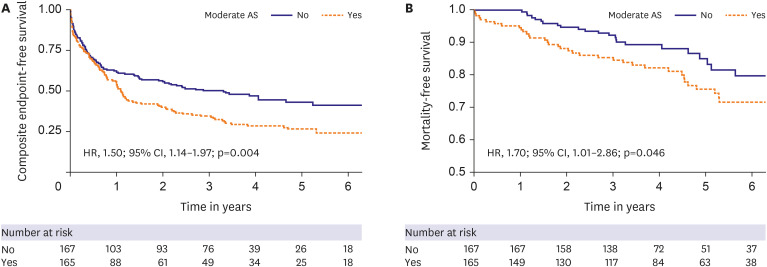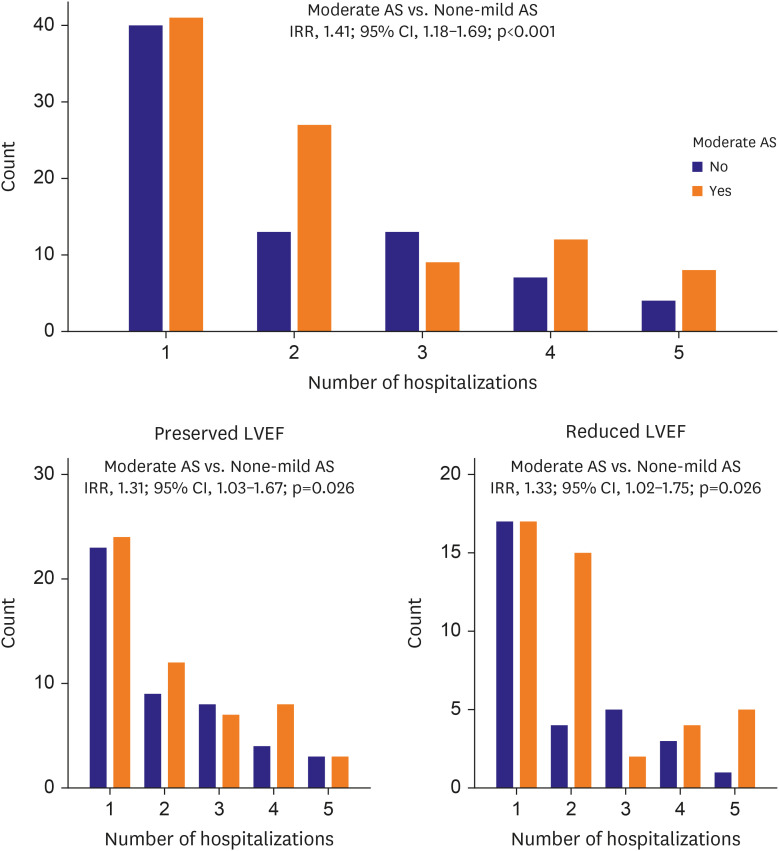Korean Circ J.
2022 Dec;52(12):878-886. 10.4070/kcj.2022.0131.
Moderate Aortic Stenosis in Patients With Heart Failure
- Affiliations
-
- 1The Christ Hospital Health Network, Cincinnati, OH, USA
- 2The Linder Research Center, Cincinnati, OH, USA
- KMID: 2536790
- DOI: http://doi.org/10.4070/kcj.2022.0131
Abstract
- Background and Objectives
Moderate aortic stenosis (AS) confers a surprisingly adverse prognosis, approaching that of severe AS. The objective of this study was to describe the clinical course of patients with moderate AS with evidence of concomitant heart failure manifesting as elevated brain natriuretic peptide (BNP) levels.
Methods
This is a single-center, retrospective cohort study of 332 patients with elevated BNP. 165 patients with moderate AS were compared with 167 controls with none-mild AS. The Median follow-up duration was 3.85 years. The primary outcome was a composite endpoint of all-cause hospitalizations and all-cause mortality.
Results
BNP levels were 530 and 515 pg/mL in the study and the control groups, respectively. Moderate AS had significantly higher rates of primary composite endpoint in both univariate analysis (hazard ratio [HR], 1.50; 95% confidence interval [CI], 1.14–1.97; p=0.004) and adjusted analysis (HR, 1.45; 95% CI, 1.05–2.01; p=0.02). Moderate AS had 1.41 (95% CI, 1.18– 1.69; p<0.001) times more all-cause hospitalization per patient-year of follow-up compared to controls in the univariate model. After adjustment for significant covariates, moderate AS remained an independent predictor of all-cause hospitalizations (incidence rate ratio [IRR], 1.45; 95% CI, 1.18–1.79; p=0.005). Furthermore, moderate AS was significantly associated with higher all-cause hospitalization rates in both heart failure with reduced ejection fraction (IRR, 1.33; 95% CI, 1.02–1.75; p=0.038) and heart failure with preserved ejection fraction [IRR], 1.31; 95% CI, 1.03–1.67; p=0.026).
Conclusions
Moderate AS in conjunction with elevated BNP portends a significantly worse prognosis than those without moderate AS and should be followed closely.
Keyword
Figure
Cited by 1 articles
-
Reconsidering the Timing of Aortic Valve Replacement in Symptomatic Normal-Flow Low-Gradient Severe Aortic Stenosis
Hsin-Fu Lee
Korean Circ J. 2023;53(11):756-757. doi: 10.4070/kcj.2023.0183.
Reference
-
1. Eveborn GW, Schirmer H, Heggelund G, Lunde P, Rasmussen K. The evolving epidemiology of valvular aortic stenosis. the Tromsø study. Heart. 2013; 99:396–400. PMID: 22942293.2. Otto CM, Kumbhani DJ, Alexander KP, et al. 2017 ACC expert consensus decision pathway for transcatheter aortic valve replacement in the management of adults with aortic stenosis: a report of the American College of Cardiology Task Force on Clinical Expert Consensus Documents. J Am Coll Cardiol. 2017; 69:1313–1346. PMID: 28063810.3. Popma JJ, Deeb GM, Yakubov SJ, et al. Transcatheter aortic-valve replacement with a self-expanding valve in low-risk patients. N Engl J Med. 2019; 380:1706–1715. PMID: 30883053.4. Mack MJ, Leon MB, Thourani VH, et al. Transcatheter aortic-valve replacement with a balloon-expandable valve in low-risk patients. N Engl J Med. 2019; 380:1695–1705. PMID: 30883058.5. Delesalle G, Bohbot Y, Rusinaru D, Delpierre Q, Maréchaux S, Tribouilloy C. Characteristics and prognosis of patients with moderate aortic stenosis and preserved left ventricular ejection fraction. J Am Heart Assoc. 2019; 8:e011036. PMID: 30841771.6. Strange G, Stewart S, Celermajer D, et al. Poor long-term survival in patients with moderate aortic stenosis. J Am Coll Cardiol. 2019; 74:1851–1863. PMID: 31491546.7. Jean G, Van Mieghem NM, Gegenava T, et al. Moderate aortic stenosis in patients with heart failure and reduced ejection fraction. J Am Coll Cardiol. 2021; 77:2796–2803. PMID: 34082909.8. Spitzer E, Van Mieghem NM, Pibarot P, et al. Rationale and design of the Transcatheter Aortic Valve Replacement to UNload the Left ventricle in patients with ADvanced heart failure (TAVR UNLOAD) trial. Am Heart J. 2016; 182:80–88. PMID: 27914503.9. Yancy CW, Jessup M, Bozkurt B, et al. 2013 ACCF/AHA guideline for the management of heart failure: a report of the American College of Cardiology Foundation/American Heart Association Task Force on Practice Guidelines. J Am Coll Cardiol. 2013; 62:e147–e239. PMID: 23747642.10. Lang RM, Bierig M, Devereux RB, et al. Recommendations for chamber quantification. Eur J Echocardiogr. 2006; 7:79–108. PMID: 16458610.11. Otto CM, Nishimura RA, Bonow RO, et al. 2020 ACC/AHA Guideline for the management of patients with valvular heart disease: executive summary: a report of the American College of Cardiology/American Heart Association Joint Committee on Clinical Practice Guidelines. Circulation. 2021; 143:e35–e71. PMID: 33332149.12. Lang T. Documenting research in scientific articles: Guidelines for authors: 3. Reporting multivariate analyses. Chest. 2007; 131:628–632. PMID: 17296672.13. Ito S, Miranda WR, Nkomo VT, et al. Prognostic risk stratification of patients with moderate aortic stenosis. J Am Soc Echocardiogr. 2021; 34:248–256. PMID: 33161066.14. van Gils L, Clavel MA, Vollema EM, et al. Prognostic implications of moderate aortic stenosis in patients with left ventricular systolic dysfunction. J Am Coll Cardiol. 2017; 69:2383–2392. PMID: 28494976.
- Full Text Links
- Actions
-
Cited
- CITED
-
- Close
- Share
- Similar articles
-
- Unicommisural Unicuspid Aortic Valve with Very Severe Aortic Stenosis in a 17-Year-Old Female
- A Case of Supravalvular Aortic Stenosis
- Successful emergency transcatheter aortic valve implantation
- A Case of Severe Aortic Stenosis Patient With High Operative Risk Treated by Transcatheter Aortic-Valve Implantation
- Multimodality Imaging for the Assessment of Severe Aortic Stenosis



